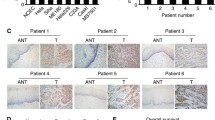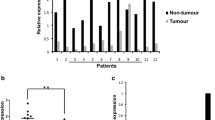Abstract
To explore and analyze the correlation between LncRNA TDRG1 expression degree and the prognosis of cervical carcinoma tissues. The cervical cancer tissues and para-carcinoma tissues of 106 patients with cervical carcinoma surgically removed in our hospital were chosen as specimens. LncRNA TDRG1 expression in cervical carcinoma tissues and para-carcinoma tissues was inspected by real-time fluorescence quantitative PCR, and the correlation between LncRNA TDRG1 and the clinicopathological parameters and disease prognosis was analyzed. The relative expression of LncRNA TDRG1 in cervical carcinoma tissues was critically gone up (P < 0.05) compared to para-carcinoma tissues. The relative expression of LncRNA TDRG1 in cervical carcinoma was correlated with FIGO staging, lymph node metastasis, infiltrating depth of cervical basal, and the differentiation of cancer cells (P < 0.05). According to the results of the Kaplan–Meier curve and Log-rank test, the overall survival conditions of subjects with low-lncRNA TDRG1 were superior to that of those with high-lncRNA TDRG1 expression (P < 0.05). The expression of LncRNA TDRG1 in cervical carcinoma tissues and the clinicopathological features in predicting the overall survival (OS) in sufferers with cervical carcinoma were investigated by the Cox regression model. LncRNA TDRG1 expression in cervical carcinoma tissues is tightly associated with the progression and prognosis of cervical carcinoma, which may be a latent biological indicator for clinical diagnosis and prognosis of cervical carcinoma.



Similar content being viewed by others
Data Availability
All data are provided in this study, and raw data can be requested from the corresponding author.
References
Zhang, M., Song, Y., & Yu, L. (2019). LncRNA PTCSC3 suppressed cervical carcinoma cell invasion and proliferation via regulating miR-574-5p. American Journal of Translational Research, 11(11), 7186.
Guo, H. M., Yang, S. H., Zhao, S. Z., Li, L., Yan, M. T., & Fan, M. C. (2018). LncRNA NEAT1 regulates cervical carcinoma proliferation and invasion by targeting AKT/PI3K. European Review for Medical and Pharmacological Sciences, 22(13), 4090–4097.
Chen, S., Tao, M., Zhao, L., & Zhang, X. (2017). The association between diabetes/hyperglycemia and the prognosis of cervical cancer patients: A systematic review and meta-analysis. Medicine, 96(40).
Qu, D., Yang, Y., & Huang, X. (2019). miR-199a-5p promotes proliferation and metastasis and epithelial-mesenchymal transition through targeting PIAS3 in cervical carcinoma. Journal of Cellular Biochemistry, 120(8), 13562–13572.
Shrestha, A. D., Neupane, D., Vedsted, P., & Kallestrup, P. (2018). Cervical cancer prevalence, incidence and mortality in low- and middle-income countries: A systematic review. Asian Pacific Journal of Cancer Prevention: APJCP, 19(2), 319.
Ding, L., Ren, J., Zhang, D., Li, Y., Huang, X., Hu, Q., & Hou, Y. (2018). A novel stromal lncRNA signature reprograms fibroblasts to promote the growth of oral squamous cell carcinoma via LncRNA-CAF/interleukin-33. Carcinogenesis, 39(3), 397–406.
Bahrami, A., Hasanzadeh, M., ShahidSales, S., Yousefi, Z., Kadkhodayan, S., Farazestanian, M., & Avan, A. (2017). Clinical significance and prognosis value of Wnt signaling pathway in cervical cancer. Journal of Cellular Biochemistry, 118(10), 3028–3033.
Park, S., Eom, K., Kim, J., Bang, H., Wang, H. Y., Ahn, S., & Lee, H. (2017). MiR-9, miR-21, and miR-155 as potential biomarkers for HPV positive and negative cervical cancer. BMC cancer, 17(1), 1–8.
Zhou, C. F., Ma, J., Huang, L., Yi, H. Y., Zhang, Y. M., Wu, X. G., & Wang, W. (2019). Cervical squamous cell carcinoma-secreted exosomal miR-221–3p promotes lymphangiogenesis and lymphatic metastasis by targeting VASH1. Oncogene, 38(8), 1256–1268.
Fan, Z., Cui, H., Xu, X., Lin, Z., Zhang, X., Kang, L., & Jiao, S. (2015). MiR-125a suppresses tumor growth, invasion and metastasis in cervical cancer by targeting STAT3. Oncotarget, 6(28), 25266.
Chen, W., Chen, X., Wang, Y., Liu, T., Liang, Y., Xiao, Y., & Chen, L. (2019). Construction and analysis of lncRNA-mediated ceRNA network in cervical squamous cell carcinoma by weighted gene co-expression network analysis. Medical Science Monitor: International Medical Journal of Experimental and Clinical Research, 25, 2609.
Zhang, Y., Na, R., & Wang, X. (2019). LncRNA WT1-AS up-regulates p53 to inhibit the proliferation of cervical squamous carcinoma cells. BMC Cancer, 19(1), 1–6.
Tong, R., Zhang, J., Wang, C., Li, X., Yu, T., & Wang, L. (2020). LncRNA PTCSC3 inhibits the proliferation, invasion and migration of cervical cancer cells via sponging miR-574-5p. Clinical and Experimental Pharmacology and Physiology, 47(3), 439–448.
Chopra, S., Gupta, M., Mathew, A., Mahantshetty, U., Engineer, R., Lavanya, G., & Shrivastava, S. K. (2018). Locally advanced cervical cancer: A study of 5-year outcomes. Indian Journal of Cancer, 55(1), 45.
Lu, J., Liu, Q. H., Wang, F., Tan, J. J., Deng, Y. Q., Peng, X. H., & Li, X. P. (2018). Exosomal miR-9 inhibits angiogenesis by targeting MDK and regulating PDK/AKT pathway in nasopharyngeal carcinoma. Journal of Experimental and Clinical Cancer Research, 37(1), 1–12.
Li, M., Li, B. Y., Xia, H., & Jiang, L. L. (2017). Expression of microRNA-142-3p in cervical cancer and its correlation with prognosis. European Review for Medical and Pharmacological Sciences, 21(10), 2346–2350.
Diao, P., Song, Y., Ge, H., Wu, Y., Li, J., Zhang, W., & Cheng, J. (2019). Identification of 4-lncRNA prognostic signature in head and neck squamous cell carcinoma. Journal of Cellular Biochemistry, 120(6), 10010–10020.
Rui, X., Xu, Y., Huang, Y., Ji, L., & Jiang, X. (2018). lncRNA DLG1-AS1 promotes cell proliferation by competitively binding with miR-107 and up-regulating ZHX1 expression in cervical cancer. Cellular Physiology and Biochemistry, 49(5), 1792–1803.
Diao, P., Song, Y., Ge, H., Wu, Y., Li, J., Zhang, W., & Cheng, J. (2019). Identification of 4-lncRNA prognostic signature in head and neck squamous cell carcinoma. Journal of Cellular biochemistry, 120(6), 10010–10020.
Guo, H. M., Yang, S. H., Zhao, S. Z., Li, L., Yan, M. T., & Fan, M. C. (2018). LncRNA NEAT1 regulates cervical carcinoma proliferation and invasion by targeting AKT/PI3K. European Review for Medical and Pharmacological Sciences, 22(13), 4090–4097.
Huang, H. W., Xie, H., Ma, X., Zhao, F., & Gao, Y. (2017). Upregulation of LncRNA PANDAR predicts poor prognosis and promotes cell proliferation in cervical cancer. European Review for Medical and Pharmacological Sciences, 21(20), 4529–4535.
Wu, X. G., Zhou, C. F., Zhang, Y. M., Yan, R. M., Wei, W. F., Chen, X. J., & Wang, W. (2019). Cancer-derived exosomal miR-221–3p promotes angiogenesis by targeting THBS2 in cervical squamous cell carcinoma. Angiogenesis, 22(3), 397–410.
Chen, W., Chen, X., Wang, Y., Liu, T., Liang, Y., Xiao, Y., & Chen, L. (2019). Construction and analysis of lncRNA-mediated ceRNA network in cervical squamous cell carcinoma by weighted gene co-expression network analysis. Medical Science Monitor: International Medical Journal of Experimental and Clinical Research, 25, 2609.
Zhang, M., Song, Y., & Yu, L. (2019). LncRNA PTCSC3 suppressed cervical carcinoma cell invasion and proliferation via regulating miR-574-5p. American Journal of Translational Research, 11(11), 7186.
Lv, K. T., Liu, Z., Feng, J., Zhao, W., Hao, T., Ding, W. Y., & Gao, L. J. (2018). MiR-22–3p regulates cell proliferation and inhibits cell apoptosis through targeting the eIF4EBP3 gene in human cervical squamous carcinoma cells. International Journal of Medical Sciences, 15(2), 142.
Liu, F., Lou, K., Zhao, X., Zhang, J., Chen, W., Qian, Y., & Zhang, Y. (2018). miR-214 regulates papillary thyroid carcinoma cell proliferation and metastasis by targeting PSMD10. International Journal of Molecular Medicine, 42(6), 3027–3036.
Author information
Authors and Affiliations
Contributions
AEAE, AGAES, and SAA – concepts, design, data analysis, statistical analysis, manuscript preparation, manuscript review, guarantor.
AEAE, RAMH, MSI – definition of intellectual content, literature search, experimental studies, data acquisition, manuscript editing.
Corresponding authors
Ethics declarations
Ethical Approval
Ethical approval was obtained from the Institutional Ethical review board (IEC) of the Faculty of Applied Medical Sciences, Umm-Alqura University, Mecca, Saudi Arabia.
Consent to Participate
Informed consent was obtained from the participants with the option to withdraw from the study at any time.
Consent for Publication
IEC, Faculty of Applied Medical Sciences, Umm-Alqura University, Mecca, Saudi Arabia, approved the publication of data generated from this study.
Competing Interests
The authors declare no competing interest.
Additional information
Publisher's Note
Springer Nature remains neutral with regard to jurisdictional claims in published maps and institutional affiliations.
Rights and permissions
Springer Nature or its licensor (e.g. a society or other partner) holds exclusive rights to this article under a publishing agreement with the author(s) or other rightsholder(s); author self-archiving of the accepted manuscript version of this article is solely governed by the terms of such publishing agreement and applicable law.
About this article
Cite this article
El-Lateef, A.E.A., El-Shemi, A.G.A., Hassanein, R.A.M. et al. Analysis of Correlation Between LncRNA TDRG1 Expression and its Prognosis in Cervical Carcinoma Tissues. Appl Biochem Biotechnol 196, 1079–1088 (2024). https://doi.org/10.1007/s12010-023-04496-9
Accepted:
Published:
Issue Date:
DOI: https://doi.org/10.1007/s12010-023-04496-9




